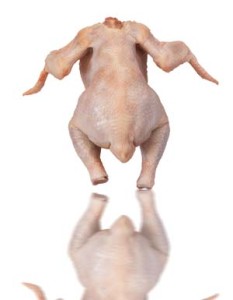Campylobacter spp. commonly infect a broad range of livestock species, pets and wild animals. In poultry they multiply in large numbers in the hindgut, principally in the caecae. A significant cause of enteritis in hymans is caused by Campylobacters and infected poultry are a potential reservoir of this zoonosis.1 It is generally assumed that Campylobacters contaminate poultry meat during processing, surviving throughout the food chain supply to constitute a risk to human health.
 The reduction of C. jejuni in the food chain, particularly from chicken products, is a major strategy in controlling the disease caused by campylobacter spp. One approach to this goal is to prevent C. jejuni colonization of broiler chickens.
The reduction of C. jejuni in the food chain, particularly from chicken products, is a major strategy in controlling the disease caused by campylobacter spp. One approach to this goal is to prevent C. jejuni colonization of broiler chickens.
The U.S. Department of Agriculture has, according to The Poultry Site, announced it will draft new safety standards for Campylobacter in poultry, in addition to the previously-announced timeline on Salmonella. These standards are expected to be ready by the end of September.
The Department took this step in response to an April letter from Senators Dianne Feinstein (D-California), Dick Durbin (D-Illinois) and Kirsten Gillibrand (D-New York) that expressed concern over food safety standards and urged the Department of Agriculture to develop better standards that would significantly reduce the levels of Salmonella and Campylobacter in poultry.
Senator Feinstein commented: “Simply put, the levels of Salmonella and Campylobacter in chicken are too high. Secretary Vilsack made the right decision to accelerate the creation of strong standards for both pathogens.
Senator Durbin said: “I am pleased to hear that the USDA is taking proactive steps to address the risk of foodborne illness by establishing strong performance standards for poultry products, including poultry parts.
Commenting on the announcement, Senator Gillibrand added: “The U.S. has made little progress in reducing the rate of foodborne illnesses from Salmonella and Campylobacter over the past 10 years, and it is time to turn that track record around. I will continue to work with Secretary Vilsack and my colleagues in the Senate to improve food safety for American families.”
1. McMullin, P. A (2004) Pocket Guide to Poultry health and Disease. 5M Publishing, Sheffield.
2. Newell, D.G. and Fearnley, C. (2003) Sources of Campylobacter Colonization in Broiler Chickens. Appl. Environ. Microbiol. August vol. 69 no. 8 4343-4351
Rob Mancini, a MS graduate of Kansas State University, is a health inspector with the Manitoba Department of Health.
